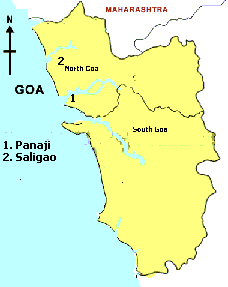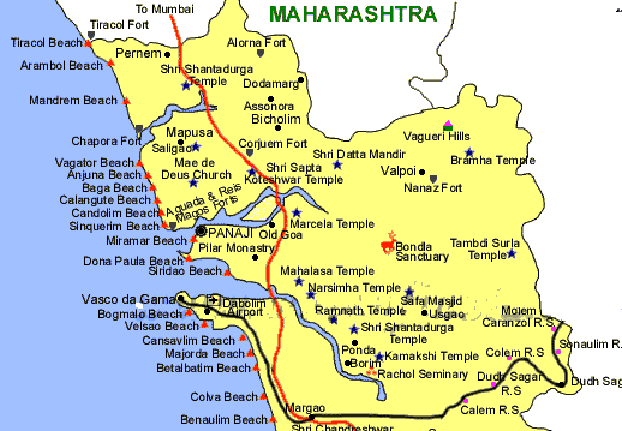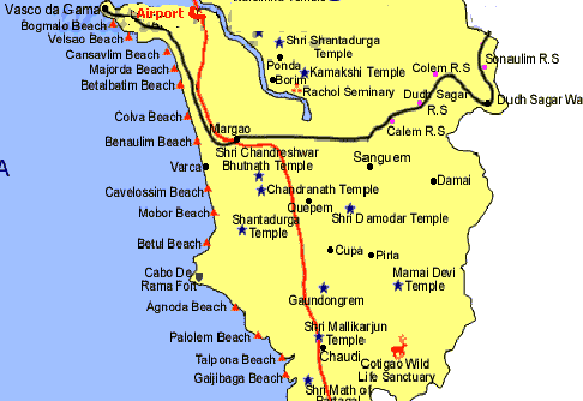Goa

Goa has been the focal point from where the Portuguese expanded their control on the trading world during the period following the discovery of the route to India by Vasco da Gama.
Before Vasco da Gama, Goa had emerged under the Kadamba dynasty around the 10th century, and was primarily concentrated around the head of the Zuari river prospering as a result of sea trade with the Arabs.
In 1347, Goa came under the Bahamani rule By 1378, it was taken by the kingdom of Vijaynagar. Bahamanis retook it in 1470 but were overtaken by the kingdom of Bijapur who under Adil Shah established a thriving port further north at the head of the Mandovi river.
Portuguese Rule
Vasco da Gama landed in Calicut in 1498 on the west cost of India, After Constantinople, the capital of the Old Byzantine Empire fell in 1452 to the Turks they blocked the Bosphorus straits route to the Europeans. The Portuguese had already explored the west coast of Africa, and were anxious to find a route to India, and have direct trade links with it to further the spice trade which was controlled by the Arab merchants.
They discovered a natural harbor in Goa. In 1510, the Portuguese obtained permission from the Court of Akbar to establish a trading post on the west coast and under Afonso Albuquerque landed in Goa, By 1543, the Portuguese were able to extend their control over Bardez, Salcette, and Marmagoa By the end of the 6th century, Goa had already reached its zenith and was referred to as "Golden Goa".
NORTH GOA

Shree Shantadurga Temple, Pernem Goa
This temple is located at Dhargal, about 14 kms from Mapusa It is dedicated to Shree Shantadurga, and is one of the few temples in Bardez that survived the Portuguese 'Inquisition' - which was a political tool, just as Washington's investigations and 'trials' of the Al Qaeda or the Nuremberg trials.
The main festival of "Zatra" falls in December and draws huge crowds.
ARAMBOL BEACH
Arambol - a beach on the North Western corner of Goa, can be approached by a road which winds through cashew groves. It is an uninterrupted and stunning stretch of undulating sand.
The people are friendly and one can learn about the local life and culture. It is a tourist spot The relaxed atmosphere and tranquility attracts many.
MAPUSA
Mapusa’s main attraction is its Friday Market where people from all over Goa come.
It has grown at the junction of roads leading to other parts of Goa and linking the city of Panjim. Closeness to Rio de Mapusa, (the Mapusa River, which in ancient times was a much used waterway for transport of agricultural products and spices) had enabled Mapusa to develop a commercial reputation.
Mapusa lies 13 kms from Panjim, now called Panaji, and has a blend of residential and commercial buildings and gardens. The beaches nearest to this town are the Anjuna and Chapora. The Kansarpal-Kalbadevi temple, is 14 km from Mapusa.
SALIGAO
Saligao, lies a short distance to the south of Mapusa. A small and picturesque town with well maintained old Portuguese villas, swaying coconut palms and lush green paddy fields. The 125 years old, parish church of Mae de Deus. with its Gothic architecture is unique as most churches and chapels of Goa are in the Portuguese style.
Saligao is surrounded by places like Parra, Guirim, Sangolda, Pilerne, Candolim, Calangute and Nagoa. Just 3 kms away is the famous Calangute Beach Saligao is an amazing sight, with its narrow path-ways and lanes. This town cradles the ancestral homes of many distinguished men and women who have made this place famous.
For the Catholic community activities are centered around the Church of Mae de Deus and the Saligao Institute (founded in 1929). The first English medium schools in Goa probably started here with the founding of the St Mary's Boys School in 1900 and later the Mater Dei Institution in 1909. The St Mary's Girls School, was the first boarding school for girls in Goa, and is today known as the Lourdes Convent.
BICHOLIM
This is the district headquarters of BIcholim taluka. It is the educational and cultural center of north Goa east of Mapusa.
PANAJI - The Capital City.
Panaji is the capital of Goa and headquarters of North Goa District, on the left bank of Mandovi river, with red-roofed houses, built in Latin style, as well as many modern houses, gardens, commemorative statues and avenues lined with flowering trees.
Panaji the capital of Goa is called by other names in Konkani. It is pronounced as Ponnji, Ponnje, or Ponjhe. The Portuguese name was Pangim. Many mostly English-speaking people still use the name Panjim.
In 1843 the Portuguese developed Panjim and named it Nova Goa (Portuguese for New Goa) when it officially replaced the city of Goa (now Old Goa) as the administrative seat of Portuguese India, though the viceroy had already moved there in 1759. Earlier it was small village on the riverfront.
Incorporated into India in December 1961, Panaji became a state capital on Goa's elevation to statehood in May 1987. Between 1961 and 1987, it was the capital of the Union Territory of Goa, Daman and Diu. A new Legislative Assembly complex was inaugurated in March 2000, across the Mandovi river, in the suburb of Porvorim. Goa's state secretariat, the seat of the bureaucracy, is also to shift to Porvorim. Panaji is also the administrative headquarters of North Goa District.
The heart of the city is the Church Square or Municipal Garden with the Portuguese Baroque Our Lady of the Immaculate Conception Church, originally built in 1541. Other tourist attractions include the Adilshahi Palace dating back to the 16th century, the Menezes Braganza Institute and the central library, the Hindu Mahalaxmi Temple, the Jama Masjid mosque, the Chapel of St. Sebastian and the Fontainhas area in general which is considered to be the Old Latin Quarter, as well as the nearby beach Miramar. Tourists find the 18th June Road a destination for shopping, particularly during the evenings. The Carnival celebrations in February include a colorful parade on the streets.
OLD GOA
This ancient historical town and former capital of Goa is located about 9 km east of Panaji. It is a world heritage site now and its fame comes from its buildings and churches built in the days when it was known as "Golden Goa". It was abandoned by the Portuguese officially in 1843 when the capital was moved to Panjim or Panaji.
Today, most of the old buildings are maintained by the archeological survey of India and the Archdiocese of Goa. It is a holy site for all Catholics particularly Goan Catholics because it is the site where the Sacred relics of St Francis Xavier are preserved for posterity from the time of his death around 1582..
Ela (Ilhas or Ilyas), used to be the capital of Goa under Adil Shah. He wanted to shift his capital from Bijapur to Ela, but the arrival of the Portuguese changed all that. Under the Portuguese it not only became the Capital of Goa but also became famous as the "Lisbon of the East". At one time its population was estimated to be around 200,000. The place declined in influence with the fortunes of the Portuguese trade which was being over-taken by the British and the Dutch. Repeated attacks of cholera and malaria frustrated the Portuguese and the Viceroy moved out of the city in 1695 to Panelim and finally to Panjim in 1759. The capital was also moved to Panaji officially in 1843. With the departure of the Viceroy and the temporary suppression Jesuits, the population fell drastically. Over the next 100 years, the buildings were allowed to fall into disrepair
A description of its churches and buildings is provided in the links below along with a short biography of St Francis Xavier, Goencho Saib.
Churches of Old Goa can view all in this page.
Se Cathedral, Old Goa
Church of St Francis of Assisi, Old Goa
Chapel of St. Catherine, Old Goa
Ruins of the Church of St Augustine, Old Goa
Basilica of Bom Jesus, Old Goa
Church of Convent of St. Monica, Old Goa
Church of Our Lady of the Rosary, Old Goa
Church of St. Cajetan, Old Goa
Chapel of St. Anthony, Old Goa
Church of Our Lady of the Mount, Old Goa
Important Buildings and Monuments in Old Goa
Viceroy's Arch, Old Goa
Archeological Museum and Portrait Gallery, Old Goa
Patron Saint of Goa
St. Francis Xavier, Goencho Saib
Bondla Forest Wildlife
50 kms., from Panaji and 38 kms. from Margao. It is one of the three wildlife sanctuaries of Goa. More than a sanctuary it is an ideal jungle resort, a major attraction for school going children and nature lovers.
Its mini zoos, sprawling deer park in natural habitat, botanical and rose gardens attract people through the year. Comfortable cottages are available here for tourists. The Zoological Park and garden at Bondla remain closed on Thursdays.
Pilar Monastery,
Venerable Fr. Agnelo - this saintly priest has put this town on the map, and is the spiritual center of Goa.
An important religious and educational center of Christian missionaries is located in Pilar. The church, seminary and school atop a hillock command a magnificent panoramic view of the countryside, with a fine view of Margao Harbor and Zuari River.
Most of Goa’s larger towns are situated in the coastal belt where the Portuguese first settled, and their character was formed slowly through the centuries of Christian rule.
The Rachol Seminary
About 3 Km. from Margao, is the small village of Raia, which is on the road from Margao to the Borim Bridge, Close by is the Rachol Seminary and Church. The old church dates from the early 1600's and the seminary has interesting architecture, and interesting paintings of Christian themes done in Indian styles. This is not a tourist site so you must ask about looking around.
This seminary has a checkered past. Originally a Muslim fortress it was first converted by the Portuguese into a church and later into a prison. In the late 16th century, it acquired respectability as a seminary for Theological Studies, with the Jesuits re-christening it from College of All Saints to the College of St. Ignatius Loyala, the name of their Founder
Margao and Vasco
Margao, is the second largest city in Goa and the principal commercial center. There are some interesting places around Margao.
A few other towns are sprinkled around the territory: Vasco da Gama is slowly developing into an industrial center: Marmagoa, Goa’s port, is one of India’s finest natural harbors. It is situated (4 Km from Vasco-da-Gama) is one of the finest natural anchorages on the West coast of India and the hub of intense maritime activity.
Other Places Of Interest in Goa
Kesarval Spring - The spring emerges from hard and compact rocks and people bathe in its water with strong belief that it has medicinal properties.
Mayem Lake - surrounded amidst rolling green hills is an ideal picnic spot. Good accommodation facilities are available in Cottages. Boating is available in the lake.
Dudhsagar Water Falls
One of Goa's most stunning natural sights is the Dudhsagar Waterfalls, said to be India’s highest. This 2000-foot torrent of water is hidden deep in the 90 square miles of the Bhagwan Mahaveer Sanctuary on the edge of Western Ghats close to the Karnataka border. A popular destination to hikers and trekkers.
SOUTH GOA

The Portuguese called it Salcette, which means Suburbs. Much of the farming takes place in this territory. It is also studded with venerable Hindu temples, as the map shows. Agnoda beach is one of the unsullied beaches in Goa.
Mangaloreans should have a particular interest in Goa, as many of their ancestors were from Goa, who had migrated to trade-centers in South Kanara, to work in the Portuguese trade posts. As this happened 450 years ago, modern day Mangaloreans have not kept themselves informed. If one goes to see closely, one finds so many similarities in the way houses in Mangalore and its neighboring talukas have been built, very much on the pattern of Goan houses. The food tastes, and the music is very similar. Even the language bears a stamp of Goa, but differs from it in script and absorption of a lot of Tulu and Kannada words in the language South Kanara is just an extension of Goa and Mangaloreans should look with pride at their ancestral land and find more about their roots.
I have had always a difficulty to locate the places my friends used to refer to. I had a very good friend Alvaro Rodrigues back in 1960 who said, he hailed from Ilyas. Now I have studied the place and know where it is. Hope when you visit Goa, you too will be familiar with the topography of this wonderful spot on the Indian sub-continent, which has given rise to all these wonderful recipes you see on this website.
Some of my articles are also posted on the Goan Forum web-site: www.colaco.net
under TGF Writers Sketchpad. I have my own dedicated Homepage there under
Tony Fernandes
| < Prev | Next > |
|---|
